Gareth Purnell heads to the upper Great Ouse to try out a theory on targeting specimen perch with the pole.
My affinity with big perch stretches back to my teenage days – maybe earlier than that. I used to go fishing all over the place with a school friend of mine – the wheels provided by his step dad who had a Birmingham Anglers Association ticket and a passion for travelling to new venues.
These were the days before carp dominated our stillwater scene and although I was lacking in the ability department I would try to make up with it with enthusiasm – we regularly fished until darkness precluded any further sport.
I recall catching two perch over 1lb 8oz one summer’s evening in the last half an hour of light. Both took a small spinner wound along what remained of a rotting wooden jetty. It was classic perch territory – I’d read enough to know that perch are drawn to structure – and I was enthralled.
To this day I don’t think there’s a sight to match the bold belligerence of a recently caught specimen perch, especially one from clear water when the famed stripes are at their most pronounced.
Whatever it was, something about them captured my imagination. I began to build a book of cuttings of big perch captures from the angling weeklies – I still have it somewhere.
I’ve had a plenty of luck with big perch since then, but although I’ve had probably 20 over 2lb, I’m still yet to land my first ‘three’, something I intend to put right soon. I’ve caught them on lobworms, maggots, casters, livebaits, spinners and plugs. I’ve caught them on pole, and rod and line, from rivers, reservoirs and stillwaters, on pleasure sessions and in matches. When there’s a chance of a big perch, count me in.
Which is how I find myself on the banks of the winding upper Ouse river today, in the company of Paddy Leigh.
Paddy has had a string of massive perch from this venue. Countless three-pounders, dozens of fours, even two five-pounders from the very length we are fishing today. It’s enough to make me drool.
For a long time I’ve believed the pole is underused on small rivers like this. Specialist anglers seem to shy away from its use, but it’s my view that it can give you one key advantage that can’t be achieved with a running line.
The river is only perhaps six to eight metres across here, so I can fish tight to the far bank if I require. But I’m actually looking for areas of overhanging branches where debris has built up, providing natural cover.
My plan is to fish the pole really tight to these features, using a bait dropper to deposit chopped worm accurately so it washes into the snag and use a big piece of lobworm.
So my first job is to put the gear down – I need a bit of a rest anyway after a walk of about half a mile – and take a tour.
The stretch is everything I could have hoped for. Two feet deep riffles give way to four and five feet deep glides. Reeds, overhanging trees, cattle drinks and rafts of debris are all plentiful – there’s even a dead sheep in one of the pegs, but I think I’ll give that one a miss today!
Overall, the whole stretch, like so many stretches of upper river, looks superb for a roving approach. But my intention today is to pick one likely looking peg and stick with it.
I’m torn between an absolutely classic raft of debris over towards the far bank taken straight from Mr Crabtree Goes Fishing and a small area 15 yards upstream of it, mid river. The first area looks the best, but overhanging branches would make it very hard to strike and land any hooked fish, so I take the safer option.
As you would expect the water mid-river is swifter, and so I opt to fish a small flat float rather than a round-bodied pattern. This will allow me to hold the rig stationary right over the baited area without fear of the float riding out of the water.
I’ve bought just one pole kit with me today, a Daiwa black Hydro elastic. I’m a bit concerned this elastic might be too stretchy, but only time will tell. I’m tying the rig up on the bank to 0.15mm PowerLine straight through to a size 12 hook. I’m using an eyed rather than spade end hook as there are some huge fish in here and I feel safer with this – there is no issue with presentation as the hook bait will cover the eye anyway.
Flat floats are the easiest in the world to set up – a small olivette is placed about two feet from the hook with two smallish dropper shot about eight inches from the hook. It pays to over-shot the float slightly so that the bristle sits down nicely when you hold it back.
When you plumb up the two dropper shot should be just off the bottom so that you have a few inches of line on the bottom when fishing.
Flat Float Rig
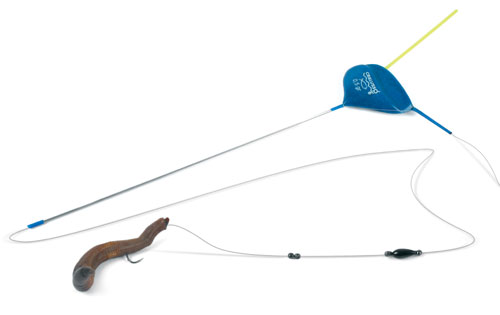 |
| Gareth’s flat float rig allows his to hold the bait still under overhanging vegetation even in fast flows. |
Plumbing up shows the depth to be about four and half feet down the middle. I shorten the line from the top of the float to about a foot so I can position the rig very tight to the feature and I’m ready to feed. That’s being done using a bait dropper, which I can drop in right next to the raft of debris. I’ve never be able to feed so accurately with another method.
I chop up six lobworms into quite large chunks and a pinch of medium dendra worms before adding a few casters and a pinch of pinkies (see tcf Top Tip). These are fed in three full bait droppers and now it’s just a case of sitting back and waiting to see if this is going to work.
My eye is taken by a sly fox quietly going about his business along the far bank. He’s working his way through a field full of sheep that don’t look in the slightest bit bothered by his presence.
I muse that the conditions certainly look in our favour today – the water has a greenish tinge and ideally I’d like to see it carrying just a bit more colour, but overcast conditions mean that there should be a good chance of a few fish feeding in the day.
Paddy has moved further upstream to a peg where he’s had big fish before. Before I go on I need to tell you about more Paddy’s incredible record on the river. He’s lost count of the number of three-pounders he’s had, has landed no less than 39 four-pounders and even two over 5lb – real dream fishing.
Most of his fish have come via a simple lobworm approach. He’s found legering using a simple two swan shot paternoster set-up to be more effective than floatfishing, and likes to induce takes by twitching the broken lobworm hook bait, which he tends to mount by threading up a size 6 hook.
But he’s also had them on Storm jelly-style jig head imitation crayfish, on which he says the takes are ‘vicious’.
And that’s the thing about the upper Ouse. The river is ‘lifting’ with crayfish and the perch and chub in particular gorge on them.
Some say that the crayfish population is not good for the river’s ecosystem as they damage spawn and kill fry populations. Paddy doesn’t agree. He believes the fantastic nutrition the fish get from their crayfish diet (apart from making them grow fast) leads to super-fit fish which, in turn, leads to healthier spawn and fry. And it has to be said there is no problem with silver fish coming through here – the river is full of them!
The downside of the massive crayfish and silver fish population on the upper Ouse is that your target fish is never more than a flap of its tail away from an easy meal. There may be a lot of specimen perch here, but persuading one to take a bait with a hook in it can be very hard.
Location, as with any form of fishing, is the real key. Paddy has found that the fish move a great deal, and he believes they move to find baby crayfish. There might be 20 superb looking swims in one short stretch, but sometimes all the perch are in one of them and you have to be lucky to choose to fish it.
You can turn things in your favour though. Rather than fish straight away, Paddy likes to leave his tackle on arrival (in a safe spot) and walk the river. Conditions have to be right. If there is too much colour in the water you’re up against it anyway. But if there’s a tinge of colour and the skies are overcast you have every chance of catching in daylight, if you can find those fish.
Hooking The Worm
 |
Step 1
Gareth prefers the head of the lobworm and splits the bait in two just below the saddle. |
|
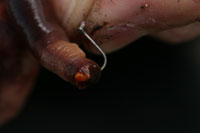 |
Step 2
The hook point goes into the wound and the worm is turned around the bend… |
|
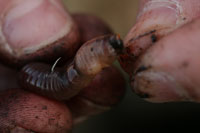 |
Step 3
… then up the shank and over the eye of the hook. |
|
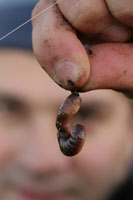 |
Step 4
The finished article – is there a perch in the world that could resist this? |
|
What Paddy is looking for is a change in the colour, which might indicate feeding fish. Paddy’s best ever catch came under just such circumstances. Closer inspection revealed a shoal of nearly 30 big perch ‘working as a team’ and taking it in turns to have a go at a tree root, which clearly held a large number of baby crayfish. As they did so they were disturbing the silt, which led to the change in the water colour. I won’t even tell you how many specimen perch he caught that day, but on other days you can easily fish classic-looking perch swims and fail to get a bite. Such is this sport we love.
I’ve read in the past that on rivers with a lot of crayfish, if you cast out a worm and get trouble from crayfish, that means there are no perch in the area and so you should move. Paddy has a slightly different interpretation on this. To him it means that the crayfish have dropped their guard and are out in the open. As already explained, he’s found that these big fish are constantly on the move and he will stick it out there in the belief that it won’t be long before the perch find the crayfish – and hopefully his hook bait.
If he can’t find any signs of fish but conditions look good, Paddy will take his time building up a couple of likely looking swims. His standard approach is to bring along with him 100 lobworms and a pint of red maggots for feeding. He’s happy to gradually introduce the bait over two or even three hours without casting a line. Often when he does though, he’ll get a specimen first cast.
But he likes to keep experimenting and today he’s livebaiting, something he admits he needs to have more confidence in. He’s fishing a float paternoster set-up, the paternoster link holding a lead that keeps the livebait down in the water. The bait is a lip-hooked, three-inch long roach, although he amazingly once had a roach of over 1lb 8oz grabbed by a huge perch!
Using The Bait Dropper
 |
Step 1
The hook is threaded through the hoop and into the cork. |
|
 |
Step 2
When feeding for perch add a few maggots or pinkies to your chopped worms and casters. These will bring in small silver fish which will in turn bring in the large perch to investigate. |
|
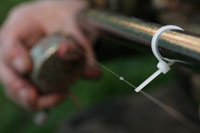 |
Step 3
The rig is placed over a cable tie on the pole as you ship out. |
|
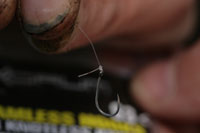 |
Step 4
Notice the tag end is left quite long – this will help hold the hook bait above the hook eye. |
|
Back at the ranch and I’ve just had my first indication. The float ‘jagged’ and I’ve no idea if it was a small fish with eyes bigger than its belly or the sign of a good fish in my swim. Two more minutes go by and the float jags again before sliding slowly away. One thing you must do with chopped worm fishing is give the fish time to take the whole bait, so I count to three and then strike as hard as I dare. I connect. The swim is tight and it’s a case of striking up hard and moving the pole to the side in one movement to prevent me from snagging branches directly above the pole.
It’s a good fish too. I ship back quickly so that I’m holding just the top three kit, and the fish is away from the snag and under my feet. It makes two or three powerful dives but the hook holds and I see the flanks of a quality perch flash two feet down. Seconds later the fish is in the net.
It’s a lovely, fat, deep-bodied and fin-perfect fish – and the scales show it to be 2lb 2oz 8dr – a great start. I go straight back in but to no avail and decide to feed again. There’s a fair wait afterwards, but again the float jags before sliding away and a second fish of almost exactly the same size is mine.
The same pattern emerges again. No bites so I feed again, and after probably another half an hour I hook one more, only this time it’s on for two or three seconds and then off. Then I land a third, and a fourth, almost the same size as the first two. I then hook a fifth, which comes off, and all goes quiet. As is so often the case this one felt bigger, but I’ll never know.
Paddy trudges up to me, laden with tackle, and I can immediately see from his expression he’s forlorn.
He’s just hooked a giant of a fish – remember he’s had them to 5lb 2oz – and he says this fish was “well over 5lb.”
The fish had the livebait in its mouth alright – he clearly saw it. But the roach was lip- hooked and he could also clearly see that the single hook was also outside the fish’s mouth – it had grabbed the roach up to its gills but no further. As it neared the net the monstrous perch let go, and his chance was gone.
Crestfallen at losing a fish most of us can only dream of, he’s decided to up sticks for the last hour of light and try another spot downstream of me. I commiserate with him and wish him luck.
I’m struggling a bit now. Wondering if there’s anything in the swim at all, I decide to try maggot. The set-up is all wrong for roach – the line is too heavy and the hook too big. But three red maggots on the size 12 immediately account for a lovely 10oz roach – a perfectly proportioned fish that’s a two-pounder in miniature. This is followed by another and then a rudd of about the same size. Heaven knows how that got in here!
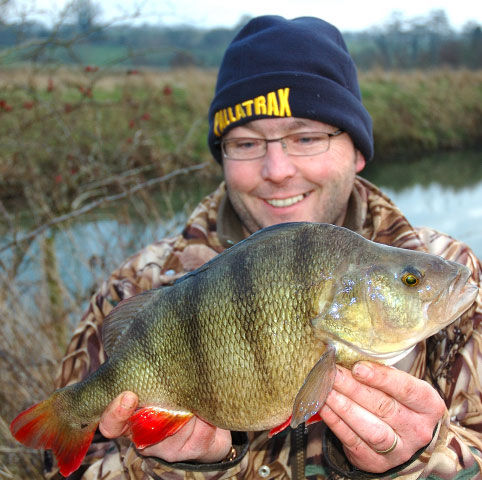 |
| Paddy with an upper Great Ouse three-pounder – he’s had an incredible 39 over 4lb plus two superb ‘fives’! |
Still fishing the maggot, the float buries again and this time it’s something altogether more belligerent. For a few seconds I think it might be my dream perch. Then I see a long shape in the water and I think I’ve hooked a thumping great chub. That’s until the fish leaps clear of the water about five times – it’s a brown trout. A good one too at around 4lb but he’s out of season and back he goes.
With the light fading I add a Starlight to the float bristle and it works surprisingly well. I fancy my chances, but as darkness descends the bites dry up completely and it’s time to call it a day.
As I’m packing up by torchlight Paddy rings in with the news that he’s had a fish of just over 2lb 8oz downstream on worm, a great way to round off a thoroughly enjoyably day’s perch fishing. He’s off to work on a new way to hook up a livebait.
Overall, today’s experiment has been a real success and I can’t wait to get back for some more. There are a couple of things I will be changing next time. The elastic needs tightening up so that I can really set the hook into the perch’s bony mouth on the strike. The balance needs to be right between getting the hook in but not having the elastic so severe that the hook then pulls out during the fight.
The second thing I’ll be doing is camouflaging the bait dropper. I had to feed for each bite but had to wait a long time between chances, and I feel that there may have been other fish in the vicinity which spooked away from the sight of the bait dropper going in again and took some time to come back.
Four more ‘twos’ but still no three-pounder for yours truly. However, I feel it’s coming. You never know, I might just stumble across one of those ‘fours’ – or even maybe a five-pounder. But now I’m dreaming again…
tcf Top Tip
Gareth likes to use an eyed hook when targeting specimen perch and leaves a long tag end to help hold the worm above the hook eye. He believes that barbless hooks give you better penetration in the perch’s bony mouth and also make unhooking easier.
tcf Top Tip
The pole is a brilliant tool for feeding bait tight to a snag using a bait dropper and presenting your bait right where the fish like to hide. Gareth chooses to use a small flat so he could present the bait hard on the bottom right in amongst the branches without the float riding out of the water.

















